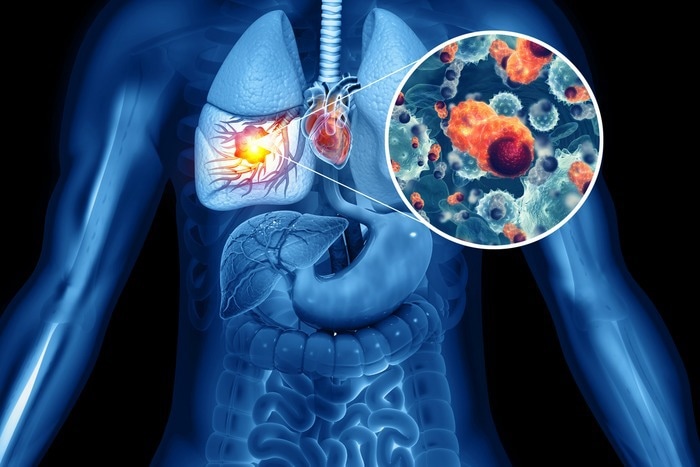Proteomics is the study and analysis of proteins in a biological system, including their structures, functions, associations, and alterations. Humans contain over 20,000 genes that generate over a million distinct protein isoforms, including an estimated 100,000 protein isoforms. These protein variations are part of the proteome’s tremendous complexity, which has mostly gone undiscovered.
 Medical Illustration showing lung cancer or bronchial carcinoma on medical background, 3d illustration. Image Credit: Mohammed Haneefa Nizamudeen.
Medical Illustration showing lung cancer or bronchial carcinoma on medical background, 3d illustration. Image Credit: Mohammed Haneefa Nizamudeen.
Protein isoforms are of considerable biomedical significance, according to a growing body of literature, since isoforms of the same protein that come from the same gene can have unique biological functions and play various roles in cellular processes. The investigation of the proteome at the protein variant level across populations can help comprehend biology and enable future scientific advances in how researchers recognize, treat, and manage the disease.
Seer scientists working with Luis Diaz, MD from Memorial Sloan Kettering Cancer Center discovered four structurally unique protein isoforms that were expressed differently in non-small cell lung cancer (NSCLC) patients. The study was published on March 29th, 2023, in the journal PLoS One.
Deep, unbiased proteomics approaches were used to compare the proteome profiles of patients with cancer against healthy subjects at the peptide-level resolution, allowing the discovery of protein isoforms that are differently expressed in NSCLC.
These findings demonstrate that distinct protein isoforms may differentially contribute to diverse biological mechanisms and to the pathogenesis of cancers, potentially paving the road to identify new diagnostic markers or new therapeutic targets. What is especially encouraging here is that these protein isoforms were detected in plasma, a readily accessible sample type, enabling cancer detection and monitoring through liquid biopsy evaluation of patients.”
Luis Diaz, Head, Division of Solid Tumor Oncology, Memorial Sloan Kettering Cancer Center
To discover disease-associated protein isoforms, the researchers examined 188 plasma proteomes from NSCLC patients and healthy controls. These protein variants play diverse roles in the body’s biological pathways and have the potential to influence disease susceptibility and development.
Seer’s deep, unbiased proteomics platform revealed multiple protein isoforms, including bone morphogenetic protein 1 (BMP1), complement component 4a (C4a), complement component 1r (C1r), and lactate dehydrogenase B (LDHB), which displayed significantly different behavior in NSCLC when compared to healthy controls.
One important isoform of the protein BMP1 had never been linked to NSCLC before. The scientists found that healthy people had higher quantities of the protein’s usual long form, whereas NSCLC patients had higher levels of a truncated variant of the protein that lacks the ability to release collagen, which could alter the tumor microenvironment. The data show that BMP1 may play a role in the pathogenesis of NSCLC.
This study identified novel disease-associated protein isoforms in NSCLC, demonstrating the utility of an unbiased analysis of the proteome at peptide-level resolution, which provides a deeper, more nuanced assessment of the human proteome. These findings underpin the importance of an unbiased approach to reveal novel biological content such as cancer-specific protein isoforms.”
Asim Siddiqui, Senior Vice President, Research, Seer
Additional study into the identified protein isoforms may confirm their significance in cancer, utility as novel biomarkers, or therapeutic promise for NSCLC. Novel protein isoforms that play a biologically important function for a range of diseases, including cancer, can be discovered by utilizing a deep, unbiased strategy to explore the proteome at the peptide-level resolution, which would otherwise not be discovered using targeted technologies.
Source:
Journal reference:
Donovan, M. K. R., et al. (2023). Functionally distinct BMP1 isoforms show an opposite pattern of abundance in plasma from non-small cell lung cancer subjects and controls. PLOS ONE. doi.org/10.1371/journal.pone.0282821.